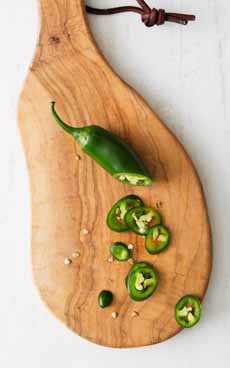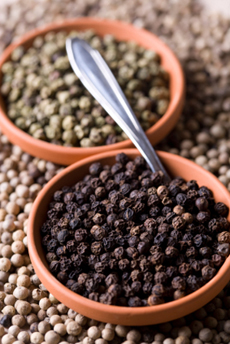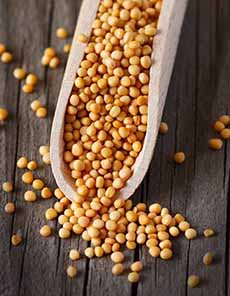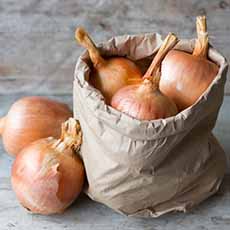|

[1] Chile peppers contain capsaicin, a chemical compound that burns (photo of jalapeño chiles © Good Eggs).

[2] In peppercorns, the heat chemical is piperine (photo iStock Photo).

[3] Yellow mustard seeds. When mustard seeds are crushed, the heat is released (photo © Hillshire Farm | Facebook).

[4] Yellow onions have the most sulphur, and thus the most burn (photo © Good Eggs).
|
|
August 19th is National Hot & Spicy Day. What makes foods hot and spicy? Why do some people temporarily cough, sneeze, sweat, or even tear up?
The heat comes from specific chemical compounds that bind to special receptors on the tongue, lips, and other parts of your mouth. These activated sensory neurons then send signals to your brain saying you’ve encountered something burning…and voilà, you experience heat or a burning sensation.
In black pepper, the compound is piperine.
In chiles, a.k.a. chile peppers, the chemical compound is capsaicin.
In ginger, it’s gingerol, which tastes hot when you have it fresh at a sushi bar, although it’s only about one thousandth as hot as capsaicin. The heat mellows a bit when cooked, but becomes more intense when ginger is dried.
In mustard and horseradish, it’s a compound called sinigrin which is a glucosinolate, a sulfur-containing compound found in cruciferous vegetables.
In onions, that eye burn is caused by sulfur. Yellow onions have the highest sulfur content of all the onions [source]. Just as different chiles have different levels of capsaicin, different onions have more heat than others.
All of these compounds elicit a sensation of burning pain by selectively activating sensory neurons that convey information about noxious stimuli to the central nervous system.
If consuming these foods causes pain, then do people continue to eat them?
First, different people have different sensitivities to the compounds, and some enjoy the burn.
Second, the painful sensations on the tongue cause the brain to release endorphins and dopamine, which are “feel good” chemicals can that give a feeling of exhilaration. At least, that’s what this source says. Personally, we’ve never felt exhilaration—only burn.
What if you want to eat hot and spicy foods but don’t want the pain?
Federica Genovese, a neuroscientist at the Monell Chemical Senses Center in Philadelphia, says that you can train your body to temper these reactions by eating spicy food more often [source].
Would you rather have an antidote to the heat?
Don’t grab a glass of water! Because capsaicin is oil-based, drinking water will just spread the capsaicin around your mouth, creating even more burning.
Capsaicin and other heat-mongers are hydrophobic, fat-soluble compounds that dissolve in fat and oil.
Have dairy products. Yogurt is the best, followed by sour cream and cottage cheese. They are acidic, and milk-based foods also contain a protein called casein, which can help break down the capsaicin. (Plant-based milks don’t work here.)
Drink something acidic. Capsaicin and other heat-generating compounds are alkaline molecules that can be neutralized with an acid: lemonade, limeade, orange juice, or tomato juice.
Have some peanut butter. The oil acts as a salve to the burning. If you’re headed to a spicy meal, you can bring a small amount of PB (it comes in squeese-packs) to dull your pain. At home, can also swirl some olive oil or other culinary oil around your mouth.
If there’s nothing else, grab some bread. It’s not nearly as good as the other options but can help to suck up some of the capsaicin in your mouth [source].
> 18 Ways To Spice It Up
> The different types of chiles.
> The different types of peppercorns.
|






